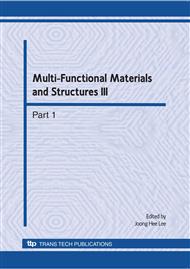p.185
p.189
p.193
p.197
p.201
p.205
p.209
p.213
p.217
Relative Post-Buckling Stiffness Calculation of Symmetrically Laminated Composite Plates Using an Exact Finite Strip
Abstract:
This paper presents the theoretical developments of an exact finite strip for the buckling and initial post-buckling analyses of symmetrically laminated composite plates. The so-called exact finite strip is developed based on the concept that it is effectively a plate. The present method, which is designated by the name Full-analytical Finite Strip Method in this paper, provides an efficient and extremely accurate buckling solution. In the development process, the Von-Karman’s equilibrium equation is solved exactly to obtain the buckling loads and the corresponding form of out-of-plane buckling deflection modes. The investigation of thin flat plate buckling behavior is then extended to an initial post-buckling study with the assumption that the deflected form immediately after the buckling is the same as that obtained for the buckling. The post-buckling study is effectively a single-term analysis, which is attempted by utilizing the so-called semi-energy method. In this method, the Von-Karman’s compatibility equation governing the behavior of symmetrically laminated composite plates is used together with a consideration of the total strain energy of the plate. Through the solution of the compatibility equation, the in-plane displacement functions are developed in terms of the unknown coefficient in the assumed out-of-plane deflection function. These in-plane and out-of-plane deflected functions are then substituted in the total strain energy expressions and the theorem of minimum total potential energy is applied to solve for the unknown coefficient. The developed method is subsequently applied to analyze the initial post-buckling behavior of some representative thin flat plates for which the results are also obtained through the application of a semi-analytical finite strip method. Through the comparison of the results and the appropriate discussion, the knowledge of the level of capability of the developed method is significantly promoted.
Info:
Periodical:
Pages:
201-204
Citation:
Online since:
August 2010
Price:
Сopyright:
© 2010 Trans Tech Publications Ltd. All Rights Reserved
Share:
Citation:


